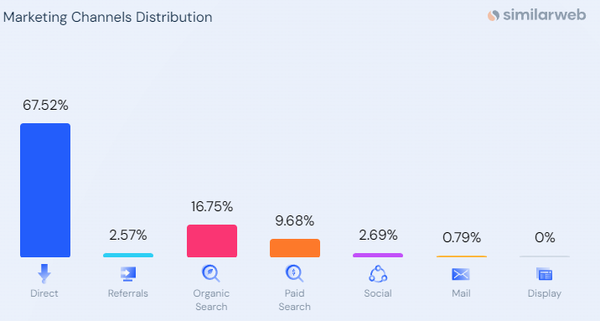SEO in Cybersecurity: A Manager’s Guide

The Importance of SEO in Cybersecurity
The digital realm is often the first touchpoint between your cybersecurity company and potential clients. The stakes in the cybersecurity industry are quite high. Clients aren't just looking for a product; they're looking for trust and credibility. A high-ranking position on Google doesn't just mean more traffic; it signifies authority. This aspect is important for cybersecurity firms, as your ranking indirectly communicates your capability to secure digital assets. It's not just about visibility; it's about perceived expertise and reliability.
The cybersecurity landscape is rife with technical jargon and complex solutions. Well-crafted SEO strategies can help demystify your offerings, translating them into language and solutions that potential clients can understand and value. This educational component of SEO can set you apart as a thought leader in the industry, someone who doesn't just sell solutions but helps the market understand them. It moves the conversation from being price-driven to value-driven, creating a more robust platform for sales and customer retention.
Pro Tip: Addressing a highly tech-savvy audience adds a layer of complexity to your marketing strategy. These decision-makers and influencers are not just knowledgeable; many also use ad blockers, rendering some traditional advertising channels less effective. Potential customers need to be educated and aware of all the risks they’re taking without the right solution.
For CEOs, CMOs, and Marketing Managers aiming for long-term brand credibility and customer engagement, an investment in SEO can yield far-reaching dividends.
SEO Strategy
You might be tempted to consider generic keywords like "cybersecurity solutions" or "network security". While these may attract a high volume of traffic, they are broad and highly competitive. Instead, focus on long-tail, intent-driven keywords that align with your strategic business objectives. For instance:
- "SaaS cybersecurity for healthcare"
- "Endpoint security for remote teams"
- "GDPR-compliant data protection"
These keywords not only target a specific audience but also align with specific business verticals you may be aiming to penetrate.
Picking the Right Keywords
Your SEO strategy should be a mirror image of your business goals. If market expansion is on the horizon, geo-targeted keywords can be integrated into your SEO strategy. For instance:
- "Cybersecurity solutions in San Francisco"
- "UK-based data protection services"
Thought leadership content should be optimized for queries that reflect this, such as:
- "Best practices in securing IoT devices"
- "Future of blockchain in cybersecurity"
Remember, your audience in this sector is often tech-savvy and discerning. Therefore, keyword strategies like "zero-trust security explained" or "benefits of multi-factor authentication" can serve dual purposes: they position you as an expert and address specific pain points or questions that your customers might have.
Creating a Customer-Centric SEO Plan
Research Competitors for Opportunities
Tools like Ahrefs or SEMRush can provide valuable insights into the keywords your competitors rank for, but you don't. It gives you the chance to create better content and gain an edge. Exploring different types of ransomware or doing an extensive topic coverage on long tail keywords from zero trust security will end up in the discovery of the right content to cover.
Understanding Your Target Audience
It's no secret that the cybersecurity audience is inherently tech-savvy. This impacts not only the kinds of keywords that will attract them but also the types of content they will find valuable. For example, surface-level content that just scratches the surface on topics like "zero-trust architecture" or "intrusion detection systems" won't cut it. Your content needs to go deeper, providing actionable insights and nuanced perspectives that this discerning audience craves.
Matching Customer Lifecycle with Keyword Intent
SEO is not a one-off event in your customer's lifecycle; it's a series of strategically placed touchpoints that guide them from awareness to conversion—and beyond. Let's break it down:
- Awareness Stage: Keywords around problem identification can be pivotal. Terms like "latest cybersecurity threats" or "best practices in data protection" could drive this audience to your resources.
- Consideration Stage: Here, your audience is actively looking for solutions. Keywords and content should shift to comparisons and solution-oriented topics, such as "endpoint vs network security" or "benefits of managed security services".
- Decision Stage: At this point, potential customers are looking for a reason to choose you over competitors. Content should focus on unique selling propositions, expert opinions, and case studies. Keywords might revolve around "your brand vs competitor brand" or "customer testimonials for your brand".
- Retention Stage: After conversion, SEO can still play a role in customer retention. Developing content around optimal use of your product, advanced tips, or industry trends can keep existing customers engaged and coming back to your site.
KPIs and Metrics That Matter
Your SEO strategy should balance both long-term and short-term objectives to be effective at driving results.
Short-Term vs Long-Term KPIs
- Short-Term KPIs: Metrics like website traffic, click-through rates (CTR), and time-on-page can provide immediate feedback on the effectiveness of your SEO efforts. They're akin to quarterly earnings—important but not the entire story.
- Long-Term KPIs: These include organic rankings, domain authority, and customer lifetime value (CLV). Think of these as your market share and brand reputation; they don't show immediate ROI but are indicative of long-term health and competitiveness.
Measuring ROI of SEO Initiatives
Return on Investment (ROI) is the holy grail of any business activity. Calculating ROI in SEO, however, isn't as straightforward as other channels due to its long-term nature. The key lies in attribution modeling, which helps you understand how SEO interacts with other channels like paid advertising or social media to contribute to conversions. For instance, while a customer might have finally converted via a direct visit, their initial touchpoint might have been an organic search that led them to a blog post months ago.
Alignment with Business Objectives
The KPIs chosen should not operate in a vacuum; they must align with the broader strategic objectives of the business. If market penetration is a key business goal, then geo-specific traffic and conversions could be pivotal KPIs. On the other hand, if brand authority is the objective, then backlinks from high-authority domains and featured snippets could become primary KPIs.
Here are some examples that help explain how different business objectives could use distinct sets of KPIs:
- Market Penetration: If your goal is to penetrate a new market—say, the UK—then high traffic from this region and top local search rankings for targeted keywords like "UK cybersecurity solutions" would be indicative of success.
KPIs: Geo-specific traffic, local search rankings, click-through rate (CTR) for localized keywords. - Customer Retention: High repeat visitor rates and deeper page views signify that existing customers find your content continually valuable, indicating successful retention strategies.
KPIs: Repeat visitor ratio, page depth, on-page engagement metrics such as comments or social shares. - Thought Leadership: Earning backlinks from esteemed cybersecurity journals or mentions in research papers elevates your brand's authority and aids in establishing it as a thought leader.
KPIs: Backlinks from high-authority industry publications, mentions, citation flow. - Revenue Growth: While traffic is good, it’s not profitable unless it converts. A high conversion rate, coupled with increasing CLV or AOV, directly correlates with revenue growth.
KPIs: Conversion rate, customer lifetime value (CLV), average order value (AOV). - Product Launch: A successful product launch would result in a spike in searches for your brand or product name and increased direct visits to your product pages.
KPIs: Branded search volume, direct website traffic, media mentions.
Content Strategy—Beyond Keywords
The implementation of a Content Governance model can be a game-changer. This is essentially a set of guidelines or a framework that ensures each content piece meets stringent quality, legal, and ethical standards. This becomes crucial in a field like cybersecurity where erroneous information can have significant consequences. The governance model could include peer reviews, expert verification, and real-world testing.
Expert Roundups
Initiate an expert round-up post where industry leaders share insights on a particular topic. This serves two purposes: First, it inherently boosts your content’s authority by association. Second, participating experts will likely share the content within their networks, widening your reach.
Solving Real Problems
Your content should aim to solve real problems that your target personas face. For example, if CISOs grapple with cloud security challenges as they move to a remote work setup, a well-researched guide on "Best Practices for Secure Cloud Migration in Remote Work" could be invaluable.
The Skyscraper Technique
Consider leveraging the Skyscraper Technique to produce standout content. This involves finding top-performing content in your niche, creating something significantly better, and then reaching out to relevant platforms to replace the old resource with your superior content. This approach not only helps in SEO but also positions you as a thought leader who improves upon existing wisdom.
Turn Strategy into Results: How I Can Help
Convert these strategic insights into tangible results for your cybersecurity business. With 7 years of industry-specific experience, I offer a customized SEO roadmap that aligns with your brand's unique challenges and opportunities.
I understand the risks that come with outsourcing crucial aspects like SEO. That's why I've structured an offer that minimizes risk while maximizing your returns:
- Performance Milestones: We set achievable KPIs together, and if they're not met within the first 60 days, I'll work at no cost until they are.
- Monthly Progress Reports: Regular, transparent reporting that tracks agreed-upon KPIs like organic traffic, conversion rates.



